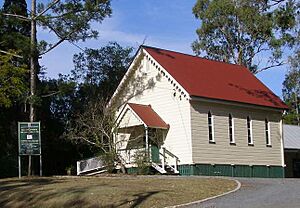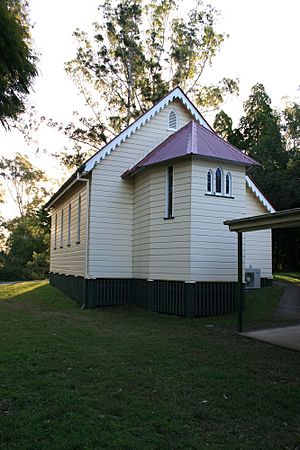Anglican Church of the Good Shepherd facts for kids
Quick facts for kids Anglican Church of the Good Shepherd |
|
|---|---|

Anglican Church of the Good Shepherd, 2006
|
|
| Location | 615 Brookfield Road, Brookfield, City of Brisbane, Queensland, Australia |
| Design period | 1870s - 1890s (late 19th century) |
| Built | 1892–1893 |
| Architectural style(s) | Gothic |
| Official name: Anglican Church of the Good Shepherd | |
| Type | state heritage (built, landscape) |
| Designated | 28 April 2000 |
| Reference no. | 601263 |
| Significant period | 1890s (historical) ongoing (social) 1890s (fabric) |
| Significant components | trees/plantings, church, views to |
| Lua error in Module:Location_map at line 420: attempt to index field 'wikibase' (a nil value). | |
The Anglican Church of the Good Shepherd is a special old church located in Brookfield, Queensland, Australia. It was built a long time ago, between 1892 and 1893. This church is so important that it was added to the Queensland Heritage Register on April 28, 2000. This means it's protected because of its history and beauty.
Contents
History of the Church
The Anglican Church of the Good Shepherd was built in 1892. We don't know for sure who designed it. However, it might have been designed by John Hingeston Buckeridge. He was the main architect for the Anglican Diocese of Brisbane from 1886 to 1902. Even though he lived in Sydney from 1892, he still helped design churches from there.
Early Days of the Church
The first Anglican priest in the Moreton Bay area was Reverend John Vincent. He arrived in 1829. For many years, people held church services in temporary buildings or even outdoors. In 1848, land was chosen in Queen's Park for the first Anglican church in Brisbane. This church was called St John the Evangelist.
When Queensland became its own colony in 1859, a new church area, or "diocese," was needed. The first Bishop of the new Diocese of Brisbane, Reverend Edward Wyndham Tufnell, arrived in 1860. He brought six young priests with him. One of them, Reverend Thomas Jones, was very important to the early days of the Church of the Good Shepherd.
Building a Local Church
By 1870, Brookfield was part of the large Toowong church area. Farmers and timber workers had settled in Brookfield in the 1850s and 1860s. Reverend Robert Creyke looked after the church members in these distant areas.
Later, a church center was set up in Indooroopilly in 1887. The Church of St Andrew opened there in 1889. Even with this new church, people in Brookfield still had to travel far. Reverend Arthur Richard Rivers visited Brookfield and encouraged the local people to build their own church. So, a special committee was formed to make this happen.
Buying the Land and Building
The land for the church was bought in October 1892 for £20. It was located at the corner of Brookfield and Boscombe Streets. The church cost £220 to build. It was officially opened on Easter Monday, April 2, 1893.
The church's design might have been based on plans from John Hingeston Buckeridge. Bishop Webber made these plans available to help local committees. This helped them figure out costs and sizes for their new churches.
Changes Over Time
To save money, the inside of the church was not painted at first. You could see the wooden beams. The roof was originally made of "stringy-bark" shingles. The small room on the north side, called a vestry, was likely added later. Adding vestries later was common if there wasn't enough money at the start.
In the 1930s, the shingle roof was replaced with iron. In the early 1950s, the inside walls were covered and painted. The area around the altar was also updated.
More repairs happened in the 1960s. The church was repainted and had new electrical wiring. The floor was fixed, sanded, and varnished.
In 1968, the church became part of a larger church area that included Kenmore and Moggill. In the 1980s, beautiful stained glass windows were added. The church was repaired again. A new hall next to the church was built in 1985. The church bell, which used to be outside the vestry, was moved to a new spot near the west entrance.
What the Church Looks Like
The Anglican Church of the Good Shepherd is a one-story wooden church. It sits on wooden posts on a small hill. The church has a main area called a nave, a chancel (the area near the altar), a north vestry, and a west entrance. There's also a separate sanctuary with its own roof and a raised floor.
The church is about twelve meters long and six meters wide. It can seat around eighty people. The outside walls are covered with white painted wooden boards.
The window at the east end of the church has three parts. The glass in these windows, including the picture of the Good Shepherd, was put in in 1981. The west wall has a central entrance and decorative wooden boards. The roofs of the main church and the entrance are made of red corrugated iron.
Inside, the main part of the church has an open wooden ceiling. All the wooden parts of the ceiling have been painted. The inside walls of the main area are covered with painted panels. The ceiling over the sanctuary is made of unpainted wood. The walls of the sanctuary are covered with clear-finished pine boards.
Tall trees like conifers and eucalypts surround the church. The Parish Hall, built in 1985, is not considered part of the church's historical importance.
Why the Church is Important
The Anglican Church of the Good Shepherd was added to the Queensland Heritage Register on April 28, 2000. This means it's recognized as a special historical place for several reasons:
Showing Queensland's History
The church helps us understand how the Anglican Church grew in Queensland and in the Brookfield area. It shows how communities developed over time.
A Great Example of Church Design
This church is a beautiful example of a timber church built in the late 1800s. It has a Gothic style. Many simple wooden churches were built in Queensland, but this one stands out because of its good design. It also fits well with other old buildings nearby, like the Uniting Church (built 1871), Brookfield School (established 1874), and the Brookfield cemetery (established 1872).
Its Beauty and Design
The Anglican Church of the Good Shepherd is important because it's a very pretty and well-made example of a Gothic-style wooden church from the late 1800s. Its design quality makes it special among the many simple timber churches built in Queensland. It also looks great with other historic buildings in the area.
Important to the Community
For over 100 years, this church has been a place of worship. It has special meaning for the local Anglican community. It's a place where people gather for religious and social reasons.


